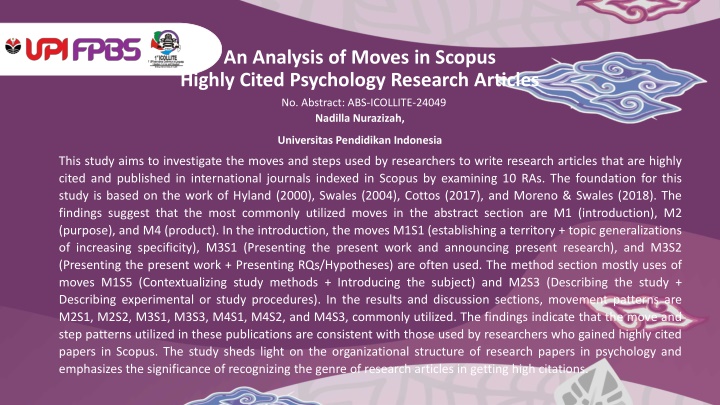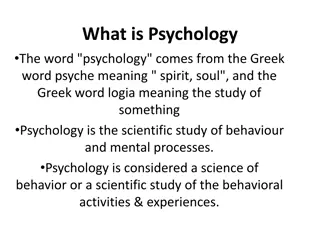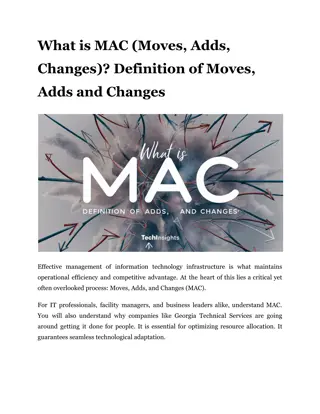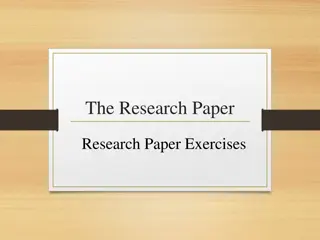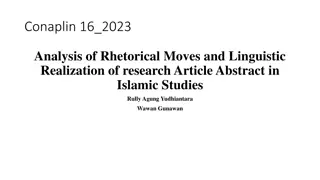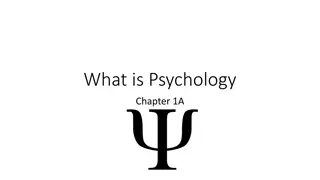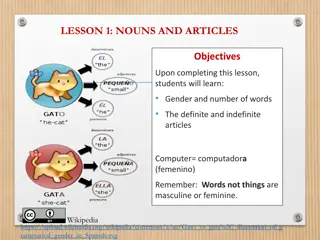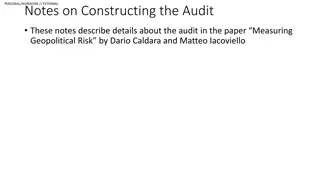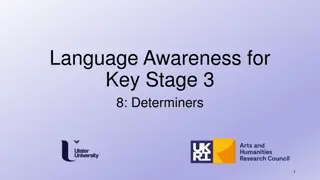Analysis of Moves in Highly Cited Psychology Research Articles
This study investigates the rhetorical moves and steps used by researchers in highly cited psychology research articles published in international journals indexed in Scopus. By examining the structure and patterns of these articles, the study sheds light on the organizational strategies that contribute to high citations in the field of psychology.
Download Presentation

Please find below an Image/Link to download the presentation.
The content on the website is provided AS IS for your information and personal use only. It may not be sold, licensed, or shared on other websites without obtaining consent from the author.If you encounter any issues during the download, it is possible that the publisher has removed the file from their server.
You are allowed to download the files provided on this website for personal or commercial use, subject to the condition that they are used lawfully. All files are the property of their respective owners.
The content on the website is provided AS IS for your information and personal use only. It may not be sold, licensed, or shared on other websites without obtaining consent from the author.
E N D
Presentation Transcript
An Analysis of Moves in Scopus Highly Cited Psychology Research Articles No. Abstract: ABS-ICOLLITE-24049 Nadilla Nurazizah, Universitas Pendidikan Indonesia This study aims to investigate the moves and steps used by researchers to write research articles that are highly cited and published in international journals indexed in Scopus by examining 10 RAs. The foundation for this study is based on the work of Hyland (2000), Swales (2004), Cottos (2017), and Moreno & Swales (2018). The findings suggest that the most commonly utilized moves in the abstract section are M1 (introduction), M2 (purpose), and M4 (product). In the introduction, the moves M1S1 (establishing a territory + topic generalizations of increasing specificity), M3S1 (Presenting the present work and announcing present research), and M3S2 (Presenting the present work + Presenting RQs/Hypotheses) are often used. The method section mostly uses of moves M1S5 (Contextualizing study methods + Introducing the subject) and M2S3 (Describing the study + Describing experimental or study procedures). In the results and discussion sections, movement patterns are M2S1, M2S2, M3S1, M3S3, M4S1, M4S2, and M4S3, commonly utilized. The findings indicate that the move and step patterns utilized in these publications are consistent with those used by researchers who gained highly cited papers in Scopus. The study sheds light on the organizational structure of research papers in psychology and emphasizes the significance of recognizing the genre of research articles in getting high citations.
INTRODUCTION Research papers (RAs) are an important part of academic communication since they transmit new information and discoveries to the scientific community. A well-structured RA facilitates effective communication by ensuring that the information is obvious to the readers (Hyland, 2000). The structure of an RA may have a considerable impact on its credibility and impact, with well-written RAs being more likely to be acknowledged and recognized in the field (Hyland, 2000). The field of psychology has seen significant advancements in research, leading to a proliferation of high-quality studies published in international journals (Halevi & Moed, 2014). The quality and impact of these studies are often measured by their citations, with highly cited articles being considered influential within the field (Gonzalez, Pereira. Et al, 2009). Scopus, a comprehensive and widely used citation database, provides a robust platform for identifying and analyzing highly cited articles across various fields, including psychology (Gupta, S. 2017). The study aimed to understand which moves and steps are used by the researchers to write their RAs that can be published in international journals such as Scopus and also achieve the highest citations. This study focuses on identifying the rhetorical moves present in highly cited psychology research articles. This study aims to answer the following two research questions: 1. What moves and steps are often used by the researchers as the papers became the highly cited RAs in the field of psychology? 2. Is the framework modified from previous work in line with the most highly cited Psychology papers in Scopus?
LITERATURE REVIEW Move is defined as discourse or rhetorical elements carrying out textual coherent communication functions. Move analysis helps academics to pinpoint the underlying norms and communication strategies that influence academic discourse in a particular subject by looking at the many "moves" or rhetorical units that make up the structure of a research publication. (Swales, 2004). Move analysis may shed light on how researchers organize their arguments, communicate their conclusions, and interact with the body of prior research regarding psychology research articles. Adel (2015) analyzed the Conclusion section of RA in Psychology, Persian Literature, and Applied Linguistics as he wanted to make a comparison. Moyetta (2016) analyzed the discussion section of English and Spanish RAs in psychology, and the author analyzed similarities between the discussion sections. Loi & Evans (2010) also analyzed the introduction section on RAs of educational psychology in English and Chinese, as they wanted to analyze the cultural differences. Yang (2022) analyzed the bundle functions and moves all RA parts within the domain of developmental and educational psychology. Several studies that have been researched move analysis by identifying all sections of the Research Articles are; Biochemistry (Davis, 2020; Kanoksilapatham, 2005), Medicine (Fryer, 2012; Huang, 2013; Li, 2009; Nwogu, 1997), Engineering (Kanoksilapatham, 2015; Maswana, 2015; Yee, 2019), Forestry (Nasirizadeh, 2022), Computer (Posteguillo, 1999), Agriculture (Huimin et al., 2014), Applied Linguistics (Wannaruk, 2016; Alamri, 2020; Fazilatfar) and Psychology (Mei Yang, 2022)
METHOD This study uses a qualitative descriptive with genre analysis approach. A corpus of 10 research articles from the highly cited journals in Psychology were selected from the Scopus database. These papers were carefully selected from highly referenced psychology publications to ensure a representative sampling of influential research on the subject. The selection process was based on some criteria; the source type, the document type, high citation and the use of English language. To support this research, we use a collaborative framework based on the work of Hyland (2000) for the abstract, Swales (2004) for the introduction, Cottos (2017) for the methodology, and Moreno & Swales (2018) for the result & discussion section. This framework provides a systematic and thorough model for analyzing the rhetorical moves and steps used in academic writing.
FINDING AND DISCUSSION ABSTRACT (Hyland, 2000) Move-Step Number of Occurences Percent (%) Move 1. Introduction 9 90% Move 2. Purpose 6 60% Move 3. Method 5 50% Move 4. Result or Product 9 90% Move 5. Conclusion 1 10%
FINDING AND DISCUSSION Move-Step Number of Occurences Percent (%) Introduction Swales (2004) Move 1. Establishing a territory (citations required) 1. Topic generalizations of increasing specificity 9 90% Move 2. Establishing a niche 1A. Indicating a gap or 3 30% 1B. Adding to what is known 2 20% 2. Presenting positive justification 0 0% Move 3. Presenting the present work (citations possible) 1. Announcing present research descriptively and/or purposively 7 70% 2. Presenting RQs or hypotheses 5 50% 3. Definitional clarifications 1 10% 4. Summarizing method 3 30% 5. Announcing principal outcomes 0 0% 6. Stating the value of the present research 0 0% 7. Outlining the structure of the paper 0 0%
FINDING AND DISCUSSION Method Cotos (2017) Move-Step Number of Occurences Percent (%) Move 1. Contextualizing study methods 1. Referencing previous works 3 30 2. Providing general information 2 20 3. Identifying methodological approach 2 20 4. Describing the setting 1 10 5. Introducing the subjects 6 60 6. Rationalizing pre-experiment decisions 1 10 Move 2. Describing the study 1. Acquiring the data 3 30 2. Describing the data 5 50 3. Delineating experimental/study procedures 9 90 4. Describing tools 5 50 5. Identifying variables 0 0 6. Rationalizing experiment decisions 0 0 7. Reporting incrementals 1 10 Move 3. Establishing credibility 1. Preparing the data 2 20 2. Describing data analysis 1 10 3. Rationalizing data processing/analysis 1 10
FINDING AND DISCUSSION Move-Step Number of Occurences Percent (%) Result Discussion & Conclusion Moreno & Swales (2018) Move 1. Announcing (function) 1. Announcing (sub)sections 2. Announcing or referring the reader to external sources 3. Announcing moves, steps or propositional meaning Move 2. Background information 1. Re-stating key features of the current study 2. Reporting background information with citations 3. Providing background information without citations Move 3. Summarizing or restating key results 1. Presenting results neutrally 2. Contrasting with other results in the study 3. Highlighting results Move 4. Commenting on key results or other features 1. Establishing the meaning of results 2. Comparing with previous research 3. Explaining results or discussing effects 4. Making predictions 5. Reacting to results or other features Move 5. Evaluating the current study or other research or practice 1. Pointing out negative features or limitations of the current study 3 0 2 30 0 20 7 6 1 70 60 10 7 1 7 70 10 70 8 6 6 1 0 80 60 60 10 0 1 10 2. Evaluating the state of knowledge or practice in broad terms 3. Stating the contribution of the current study 4. Pointing out positive features of the current or proposed study 5. Noting specific gaps in knowledge or deficiencies in other research or practice 5 2 5 4 50 20 50 40 Move 6. Drawing implications 1. Making recommendations for future research or practice 2. Suggesting the applicability of results or usability of outcomes 3. Hypothesizing for future research Move 7. Elaborating (function) 1. Justifying what is stated in a neighboring proposition 2. Exemplifying what has been stated in a previous proposition 3. Clarifying what has been stated in a previous proposition 5 2 1 50 20 10 1 1 1 10 10 10
CONCLUSION The analysis of highly cited psychological research articles in Scopus demonstrates that academics routinely follow precise movements and processes to arrange their studies. The findings of these moves and steps refer to the theory of Kanoksilapatham, 2005. The theory shows the size of moves and steps categorized into 2 types, namely conventional (>60%) and optional (<60%). The following results are the categories of moves that fall into conventional moves and steps. In the abstract part, the most typical movements are M1 (introduction), M2 (purpose), and M4 (product). The motions M1S1 (creating a territory + subject generalizations of increasing specificity), M3S1 (presenting the present work and announcing the present study), and M3S2 (presenting the present work + presenting RQs/hypotheses) are widely used in the introduction. The method section mostly employs movements M1S5 (contextualizing study methods and introducing the subject) and M2S3 (describing the study and describing experimental or study procedures). In the results and discussion sections, the most often used movements are M2S1, M2S2, M3S1, M3S3, M4S1, M4S2, and M4S3. The findings show that the move and step patterns employed in these publications are in line with those used by researchers with highly cited articles in Scopus. The study sheds light on the organizational structure of research papers in psychology and underlines the importance of recognizing the genre of research articles in obtaining high citations.
REFERENCES Hayes, G. (2023). Introduction to psychology. Davis, R. H. (2020). Moves and steps in the IMRD sections of medical research articles. Taiwan International ESP Journal, 11(1), 23-39. Fryer, D. L. (2012). Analysis of the generic discourse features of the English-language medical research article: A systemic-functional approach. Functions of language, 19(1), 5-37. Huang, D. A. N. I. E. L. (2014). Genre analysis of moves in medical research articles. Stylus, 5(1), 7- 17. Kanoksilapatham, B. (2015). Distinguishing textual features characterizing structural variation in research articles across three engineering sub-discipline corpora. English for Specific Purposes, 37, 74-86. Kanoksilapatham, B. (2005). Rhetorical structure of biochemistry research articles. English for specific purposes, 24(3), 269-292. Koutsantoni, D. (2006). Rhetorical strategies in engineering research articles and research theses: Advanced academic literacy and relations of power. Journal of English for Academic Purposes, 5(1), 19-36. Basim, A. (2020). A comparative study of Saudi and international journals of Applied Linguistics: The move-bundle connection approach. Journal of Language and Education, 6(2 (22)), 9-30. Li, L. J., & Ge, G. C. (2009). Genre analysis: Structural and linguistic evolution of the English-medium medical research article (1985 2004). English for Specific Purposes, 28(2), 93-104. Maswana, S., Kanamaru, T., & Tajino, A. (2015). Move analysis of research articles across five engineering fields: What they share and what they do not. Ampersand, 2, 1-11. Nasirizadeh, Z., Paramasivam, S., Nimehchisalem, V., & Omar, N. (2022). Rhetorical Structures and Cyclical Patterns in Forestry Research Articles. GEMA Online Journal of Language Studies, 22(2). Nwogu, K. N. (1997). The medical research paper: Structure and functions. English for specific purposes, 16(2), 119-138. Posteguillo, S. (1999). The schematic structure of computer science research articles. English for specific purposes, 18(2), 139-160.
THANK YOU! Follow us @...
